Are PBDEs in your house? Understanding the impacts of PBDE chemicals on the development of diabetes
New research from UC Riverside conducted on animal models suggests that maternal exposure to common flame retardants called PBDEs causes diabetes in offspring. The findings, published in Scientific Reports, harps on the danger of PBDEs and calls for improved regulation of the toxic chemicals.
"PBDEs are everywhere in the home. They're impossible to completely avoid," said UCR neuroscientist and corresponding author of the study, Dr. Margarita Curras-Collazo. PBDEs are added to furniture, upholstery, and electronics in order to prevent fires, yet they easily detach from these surfaces and make their way into the air we breathe every day.
"Even though the most harmful PBDEs have been banned from production and import into the U.S., inadequate recycling of products that contain them has continued to leach PBDEs into water, soil, and air. As a result, researchers continue to find them in human blood, fat, fetal tissues, as well as maternal breast milk in countries worldwide."
It is this transfer of PBDEs from mother to child that concerned the scientists conducting this study. The team’s experiments on mice showed the correlation between adult diabetes in offspring and maternal exposure to the chemical.
"The mice received PBDEs from their mothers while they were in the womb and as young babies through mother's milk," said lead author Elena Kozlova, who is a nueroscience PhD candidate at UC Riverside. "Remarkably, in adulthood, long after the exposure to the chemicals, the female offspring developed diabetes."
As Kozlova highlights, all of the adult mice offspring exposed to the chemicals as babies showed symptoms of diabetes, including glucose intolerance, high fasting glucose levels, insulin insensitivity, and low blood insulin levels. They also detected high levels of endocannabinoids in the livers of the offspring. These molecules are associated with appetite, metabolism, and obesity. Meanwhile, the mother mice did not seem to be as affected by the chemicals as their offspring, although they did develop some glucose intolerance.

"This study is unique because we tested both the mothers and their offspring for all the hallmarks of diabetes exhibited in humans," Curras-Collazo added. "This kind of testing has not been done before, especially on female offspring."
"Our findings indicate that chemicals in the environment, like PBDEs, can be transferred from mother to offspring, and exposure to them during the early developmental period is damaging to health," Curras-Collazo said. The plan to continue their investigations by conducting longitudinal studies in humans. "We need to know if human babies exposed to PBDEs both before and after birth go on to become diabetic children and adults," Kozlova concluded.
Sources: Scientific Reports, Eureka Alert








